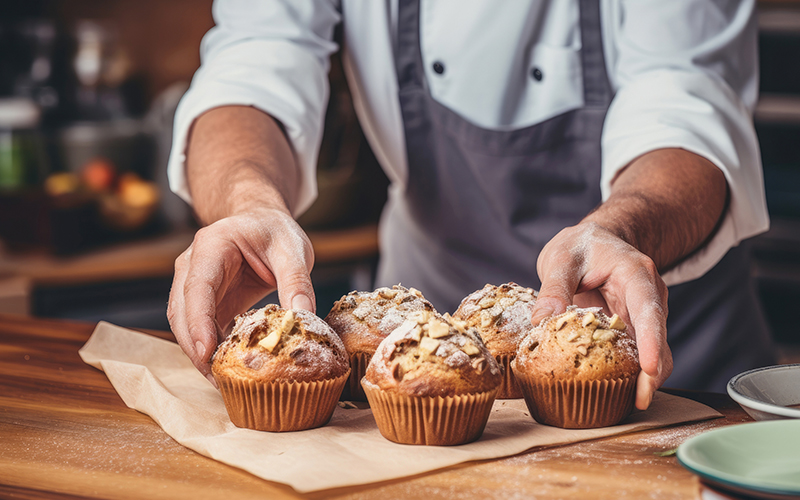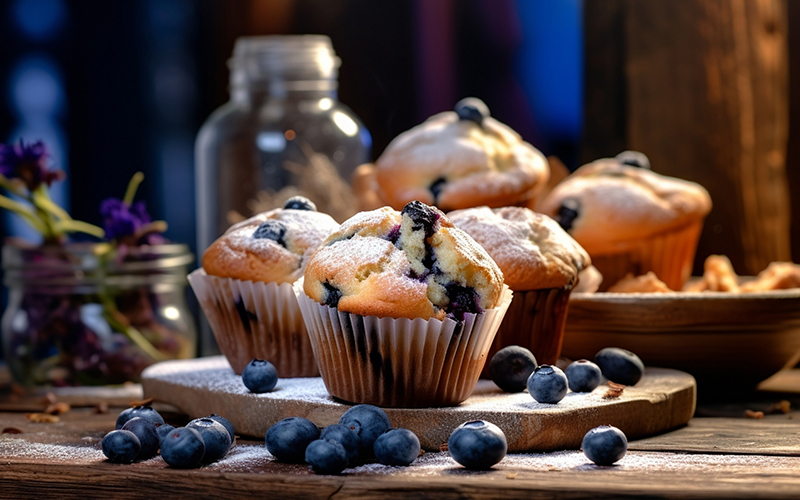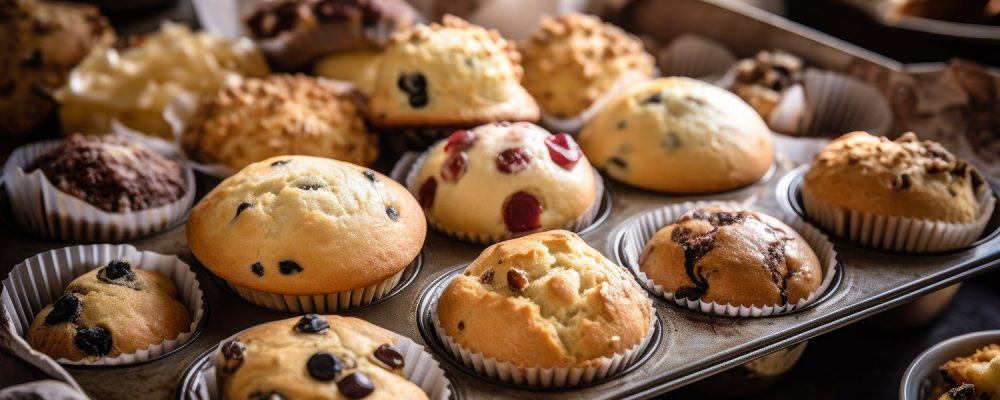Many people think that a gluten-free lifestyle means living a life devoid of taste, but we’re about to prove that wrong! The internet is full of delicious recipes that can easily be converted to gluten-free, and these muffins are a perfect example of that.
Aside from being the perfect treat for those with gluten sensitivities, these recipe guidelines offer healthy choices that are full of flavor. Incorporating ingredients that offer health benefits can elevate the nutritional value of these muffins. Berries, known for their antioxidant properties, can add a burst of flavor and color.
Similarly, dark chocolate chips, while seemingly decadent, can also offer beneficial antioxidants. Additionally, incorporating fragrant spices into the recipe will not only enhance the muffin’s flavor profile, but may also potentially contribute to overall general health and wellness. By combining these elements, you can create muffins that are both delicious and nourishing for the body and soul.
Primary Ingredients for Gluten-free Muffins
2 cups of a gluten-free flour blend: The foundation of gluten-free baking, this blend typically includes a mixture of rice flour, almond flour, and tapioca flour. It ensures a suitable texture and taste for those with gluten sensitivities.
1 teaspoon of baking powder: This is a leavening agent that’s needed for the muffins to rise and become fluffy so that traditional wheat-based ingredients aren’t necessary.
1/2 teaspoon of baking soda: Works alongside baking powder to promote leavening, contributing to the light and airy texture of the muffins.
half teaspoon of salt: Salt rounds out the flavor of the muffins by balancing sweetness and also providing a subtle savory profile.
1/2 cup unsalted butter: Butter adds moisture and richness to the muffins, contributing to their tender crumb. Coconut oil is a dairy-free alternative.
1 cup of sugar: Provides sweetness to the muffins, balancing the flavors. Various sweeteners can be used, catering to dietary preferences.
2 large eggs: Eggs act as a binding agent and contribute to the structure and moisture of the muffins. Flax eggs (made with flax meal) can provide an egg-free alternative.
1 cup of yogurt: Enhances the moistness and tenderness of the muffins, contributing to a soft and enjoyable texture. Dairy-free alternatives can be used for those who have lactose intolerance.[1]
1 teaspoon of vanilla extract: Infuses a warm and aromatic flavor, complementing the sweetness of the muffins.
Step-by-Step Instructions for Making Gluten-free Muffins

Preheat the Oven
Start preheating your oven to 350°F (175°C). Next, line a muffin tin with paper liners or grease it lightly with butter or coconut oil to prevent sticking.
Combine Dry Ingredients
Mix the gluten-free flour blend, baking powder, baking soda, and salt in a medium-sized bowl. Ensure an even distribution of ingredients for a uniform muffin texture.
Mix Wet Ingredients
In a larger, separate bowl, mix the melted butter and sugar until thoroughly combined. Add the eggs, one at a time, beating well after each addition. Next, stir in the yogurt and vanilla extract until the mixture is smooth.
Adding Dry Ingredients
Gradually add the dry ingredients to the wet ingredients, mixing until just combined. Be careful not to overmix, as this may affect the texture of the muffins.
Assemble Muffin Cups
You can use a measuring spoon or a ladle to evenly distribute the batter into the prepared muffin cups.
Bake
Next, slide the muffin tin into the preheated oven and bake for about 18-22 minutes until the tops of the muffins turn golden brown. To check if the muffins are cooked all the way through, insert a toothpick into the center of one of the muffins until it comes out clean.
Serving Suggestions
Make your gluten-free muffins more enjoyable by serving them in clever ways and pairing them with foods that enhance their flavor. Here are some good suggestions:
Whipped Toppings: You can add a generous amount of whipped cream or a dairy-free option on top of your gluten-free muffin.
Fresh Berries: You can place fresh berries like blackberries, blueberries, or strawberries on the side of your muffins. The natural sweetness goes really well with the muffins.
Honey: If you want to drizzle some honey over warm muffins, it will make them taste even better and add a delicious sweetness.
Citrus Zest: To add a little zing, you can sprinkle a little orange or lemon zest on top of them.
Nut Butter: Spread your best nut butter on the muffins for a rich and satisfying taste. You can use different types of butter, such as almond butter, peanut butter, or cashew.
Recipe Variations

Gluten-free muffins can be made to suit every taste. Here we’ve provided a range of flavors from savory to sweet. All you need to do is add or replace a few ingredients from the basic recipe outlined above.
English Breakfast Muffins: To make these muffins taste like an English breakfast, beat gluten-free flour with chopped bacon, sharp cheddar cheese, and chives. These savory muffins are a great way to start the day.
Chocolate Chip Orange Delight: You can add dark chocolate chips and orange zest together to make a rich and tasty treat.
Banana Nut Bliss: To make a basic banana muffin even better, you can chop some walnuts or pecans and add them to the batter. Ripe bananas combined with crunchy, savory nuts makes for a healthy and satisfying treat .
Pumpkin Spice Extravaganza: This pumpkin spice muffin version that uses canned pumpkin, cinnamon, nutmeg, and cloves can also be a fantastic option.
Lemon Poppy Seed Elegance: Adding lemon zest and poppy seeds to your muffins for this classic recipe.
Berry Medley Marvel: Add different kinds of berries, like blueberries, raspberries, and strawberries, to make a bright and healthy muffin with sour and sweet notes.
Carrot Cake Fusion: You can take the traditional carrot cake and convert it to gluten-free muffins by grating carrots, adding warm spices, and a dash of cream cheese.
Almond Joy Temptation: You can make your muffins taste like the famous candy bar by mixing in shredded coconut, chopped almonds, and dark chocolate chips.
Carb Calculation and Nutritional Info
The nutritional breakdown for each serving is based on the estimated values for each ingredient used. Actual calculations will vary.
Total Net Carbs Calculation for the Recipe
Gluten-Free Flour Blend 2 cups
Total Carbs = 190g
Baking Powder 1 teaspoon
Total Carbs = Approximately 1g
Baking Soda 1/2 teaspoon
Total Carbs = Approximately 0.6g
Salt 1/2 teaspoon
Total Carbs: Salt is carb-free
1/2 Cup Unsalted Butter melted
Total Carbs = None
Sugar
Total Carbs = Approximately 200g
2 Large eggs
Total Carbs = Approximately 1.2g
Vanilla Extract 1 teaspoon
Total Carbs = Approximately 1.6g
Yogurt or Dairy-Free Alternative 1 cup
Total Carbs = Varies based on the type of yogurt used.
Other Nutritional Information
Calories: Calories vary based on specific ingredient brands and quantities. On average, gluten-free muffins are around 150-200 calories per muffin.
Protein: Approximately 4-6 grams per muffin. Depending on the type of gluten-free flour blend, eggs, and yogurt used, protein content may vary.
Fat: Approximately 8-12 grams per muffin. The fat content is influenced by ingredients like butter or coconut oil.
Other Nutrients: Varies based on the specific ingredients used. In addition, the recipe may provide small amounts of vitamins, such as A, D (from eggs), and also B-complex vitamins. Minerals like calcium (from yogurt) and sodium (from salt) may be present.
Storing and Reheating
Storing
When planning to reheat the muffins, it’s important to do so properly so that moisture and flavor can be maintained. One easy method is to lightly toast them in the oven or toaster oven for a few minutes. This will help revive the texture and bring out the flavors without drying them out.
Remember to keep an eye on your muffins to prevent overheating. By following these simple storage and reheating tips, you’ll be able to enjoy flavorful gluten-free muffins for a long time.
Additionally, freezing the muffins not only allows them to be stored for the long-term, but it’s also a great way to get longevity out of this recipe. This way you can ensure that they stay fresh for an extended period. So whether it’s weeks or even months later, you can still enjoy your homemade muffins whenever you crave them.
Reheating
Lastly, when it comes to reheating frozen muffins, it’s best to have them either thaw overnight in the refrigerator or at room temperature. If you’re finding that the muffins are still partially frozen after thawing, then you can always reheat them in the microwave for a quick 15 to 20 seconds on medium heat.
If you prefer a crispier texture, however, then it’s recommended that you utilize a conventional oven. For this method, preheat the oven to 350°F (175°C), wrap each muffin in aluminum foil, and then warm them for 10 to 15 minutes.
Sadly, when excessively heated, gluten-free baked goods have a tendency to dry out faster than those that contain wheat or gluten. However, this issue can be rectified by simply adding a small cup of water to your oven while warming the muffins. This will help them to retain moisture so that each bite remains soft and fluffy.
Final Thoughts
Living a gluten-free lifestyle doesn’t mean that you have to give up flavor. In fact, gluten-free products and recipes have come a long way over the years.
Today, it’s fairly easy to bake gluten-free blueberry muffins — and variations of them — from scratch. And consequently, it’s even easier to store, thaw, and reheat the muffins while keeping that lovely blueberry flavor intact.
While stepping into a gluten-free lifestyle can feel a bit challenging at first, the good news is that there are plenty of recipes, tips, tricks, and resources to help you out along the way. Finally, if eating a clean, nutrient-dense diet and living a healthy lifestyle are among your top priorities, don’t worry, you’ll definitely be able to do both while on a gluten-free diet.
RV Team
* Reviewology is in partnership or collaborates with top brands highlighted on this site, including those occupying the top ranking positions.
Additionally, we earn affiliate commissions from products showcased on this website when you make a purchase through the provided links on Amazon or the company website directly.
We appreciate your support using our links to purchase your favorite brands or newly discovered brands.
Latest updates
I Thought I’d Always Feel Tired, Fat, and Forgotten—Until This
310 Greens vs AG1
The Truth About 310 Greens: A No-Nonsense Review of This Popular Supplement
Popular
I Thought I’d Always Feel Tired, Fat, and Forgotten—Until This
310 Greens vs AG1
The Truth About 310 Greens: A No-Nonsense Review of This Popular Supplement
© 2024 Reviewology. All Rights Reserved.
